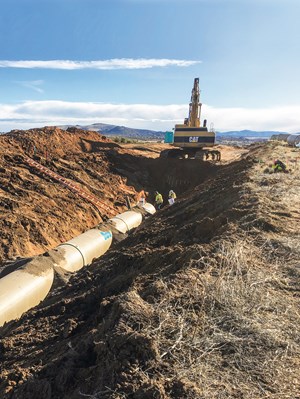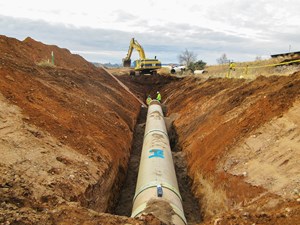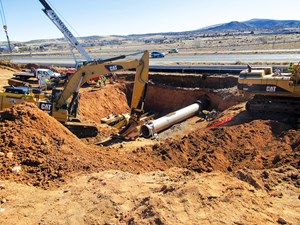August 2020 Vol. 75 No. 8
Features
Poised for Progress: Prescott One Step Closer to Centralized Wastewater System
Kimberly Paggioli, P.E. | Hobas Pipe USA
The popular adage “out with the old, in with the new” is often associated with enthusiasm and fanfare. Yet, in the world of sewer replacement and expansion, the true test of a successful project is having the work go almost unnoticed by the public.

Such is the case in Prescott, a central Arizona desert city with a population of more than 43,000, just 96 miles northwest of Phoenix and a scenic, two-hour drive from the Grand Canyon.
Prescott, the seat of Yavapai County, has experienced a surge of residents, as well as visitors, in recent years. According to the World Population Review, the city is growing at a rate of 0.93 percent annually and its population has increased 10.75 percent since the most-recent census in 2010.
Contributing to Prescott’s year-round appeal are a vibrant pioneer history, which began before the city became a territory capital in 1864; outdoor attractions from lakes to golf courses; temperate climate; seasonal festivals; and unique shopping venues.
With watchful eyes on the future, city leaders have taken significant measures to update an essential part of Prescott’s infrastructure.
Growth spurs project need

“The Airport Water Reclamation Facility (WRF) Trunk Main Project was needed to support the city’s growth and is part of its overall plan for centralization of the wastewater system to one treatment plant,” said Richard Poynor, P.E., vice president of Lyon Engineering. “The project affects at least 15 different properties – industrial, residential and ranch land – and goes through an existing right-of-way, underneath State Route 89A.”
“We currently have two wastewater treatment facilities,” added Craig Dotseth, director, City of Prescott Public Works. “This pipeline will allow us to continue on the centralization path to reduce operations and maintenance costs for our wastewater treatment system.”
The selection of materials, made by city engineers several years ago, included Hobas centrifugally cast, glass-fiber-reinforced polymer mortar (CCFRPM) pipes.
“Hobas pipe was chosen because of its corrosion-resistance capabilities, superior joints to prevent infiltration and root intrusion, and its life-cycle cost,” noted Eric Bay, P.E., manager, Prescott Utilities. “Over the past three years, we’ve been installing Hobas pipe in different phases of the overall Airport Trunk Main Project.”
Dotseth, a Grade 4 certified operator in water treatment, water distribution, wastewater treatment and wastewater collection, pointed out the value of using durable materials.
“When we are asked about the project, what we’ve considered is that 100 years from now, anyone who follows us in our jobs, in our profession, will find this system will still be there taking care of the city,” he said. “The entire gravity system that we’re building is completely corrosion-resistant – from pipe to composite riser rings and covers.”
Phase 1, the first and shortest of three phases, began in December 2016 and was completed by March 2017.
“Phase 2B replaced an existing 18-inch and 24-inch sewer line that was over capacity,” Poynor said. “We wanted a sewer pipe that would last at least 50 years, so we replaced the sewer line with two and a half miles of 36-inch and 48-inch Hobas pipe. The terrain is hilly and in some places, the pipe goes to depths of 24 feet.”
Phase 2

The installation of a 48-inch sewer main which spanned 4,550 feet was the goal of Phase 2a, which started in January 2019 and finished in May 2019.
“The manholes are made of composite polymer concrete material, so they don’t corrode,” Poynor added. “The fittings in the manholes were installed at the factory. When the manholes arrived, workers were able to plug the Hobas pipes right into them. This step saved time and made for a cleaner installation.”
The objective of Phase 2b, which commenced in October 2019, was to install 10,960 feet of 36-inch pipe and 48-inch pipe to replace an existing, over-capacity, 18- and 24-inch sewer line. “We wanted a sewer pipe that would last at least 50 years,” Poynor said.
The sewer was finished by May 2020, even though it was given 480 days for completion.
“Very surprising” is how Poynor described Phase 2b’s time frame. “One stretch that involved the installation of 48-inch pipe was 320 feet long. A pipe had to go inside of a 72-inch steel casing that was tunneled under a State Route 89A interchange – an active highway – with no shutdowns.
“The bypass plumbing was one of the biggest tasks that Fann Contracting, the contractor for all three phases, had to do. The workers actually dug the hole by hand without using the auger machine.”
Considered a separate project, the Sundog Lift Station and the Sundog Trunk Main are located about three miles upstream.
“Right now, they are further down in the system as far as being able to move and change how the system currently works for the centralization,” Dotseth said. “The design is complete, and we are working with a community partner in obtaining easements to allow the project to go forward.”
Plans call for the Sundog Wastewater Treatment Plant to eventually go off-line and connect to the expanded Airport Water Reclamation Facility, about one-half mile from the state’s third-busiest airport. With capacity of 3.75 million gallons per day, the facility currently treats wastewater from residential, commercial, and industrial sectors. •
FOR MORE INFORMATION:
Fann Contracting, (928) 778-0170, fanncontracting.com
Lyon Engineering (928) 776-1750, lyonengineering.com
Hobas Pipe USA, (800) 856-7473, (281) 821-2200, hobaspipe.com




Comments